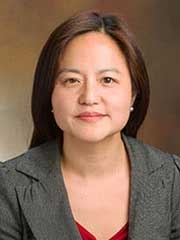Pediatric Reflections: Delivering In-Depth Advice to Parents’ Phones, Computers
Published on
Children's DoctorPublished on
Children's DoctorTogether Julie Kardos, MD, medical director of CHOP Primary Care, Newtown, and Naline Lai, MD, medical director of CHOP Primary Care, Central Bucks, write the Two Peds in a Pod blog.
 Julie Kardos, MD
Before becoming a pediatrician, I took undergraduate creative writing classes. I pledged to use my love of writing someday as a pediatrician. On the first day of my pediatric residency at Children’s Hospital of Philadelphia, I met fellow resident Naline Lai, a former college newspaper journalist, and discovered that we were two peas in a pod. We promised each other that together we would someday write a modern parenting book.
Julie Kardos, MD
Before becoming a pediatrician, I took undergraduate creative writing classes. I pledged to use my love of writing someday as a pediatrician. On the first day of my pediatric residency at Children’s Hospital of Philadelphia, I met fellow resident Naline Lai, a former college newspaper journalist, and discovered that we were two peas in a pod. We promised each other that together we would someday write a modern parenting book.
Then we got busy. Our practices were busy, and the families of our patients were busy. We had too many things to tell parents and not enough time. “Why should I vaccinate my child?” and “What are ways I can feed my newborn/picky eater/underweight child/overweight child?” are not short answer questions.
 Naline Lai, MD
Parents needed pediatric health information to digest on their own time and at their own pace. It was time to write our parenting book. However, we realized that no one read books! In fact, even our short, printed handouts often got left behind as parents rushed out of our office doors for soccer practice.
Naline Lai, MD
Parents needed pediatric health information to digest on their own time and at their own pace. It was time to write our parenting book. However, we realized that no one read books! In fact, even our short, printed handouts often got left behind as parents rushed out of our office doors for soccer practice.
We realized that our patients’ parents were turning to something new (back then) called the internet to find pediatric information. To meet their needs, in 2009, the “two peas in a pod” created Two Peds in a Pod®. The blog, at twopedsinapod.org, contained “practical pediatrics for parents on the go.” Unlike pieces of misplaced paper, the internet was always available. The idea that doctors would write advice on the internet was so novel back then that even NPR thought the concept worthy of a story.
Now, we could say to parents, “Here is a short answer to your question, and you can read more at home in detail in Two Peds in a Pod.” Additionally, when we receive emails from parents in our patient portals, instead of writing out long paragraphs, we often send parents links to appropriate posts.
One unanticipated and exciting “side effect” of writing our blog has been to provide other pediatricians around the world with content for their own websites and social media pages. For example, we are proud to be in the blogrolls of Singing Doctor Josh and Keep Kids Healthy. We invite all pediatricians to link to our posts.
We tell our patients, “I wish I had AN HOUR with you at every office visit to teach you! But, I can give you the next best thing.” And we send them to our blog.
Visit twopedsinapod.org and share the link with your families. You can also link to it from your office’s website.
Contributed by: Julie Kardos, MD, FAAP, Naline Lai, MD, FAAP
Categories: Children's Doctor Winter 2020, Pediatric Reflections